Cycling helmets have come a long way since the 1880s when they only offered minimal protection. Today, advancements in materials and safety standards have led to helmets equipped with technologies like MIPS and Wavecel that greatly reduce head injury risks. Innovations in design now include custom-fit options and smart features like Bluetooth connectivity. As you explore further, you'll discover even more about the future of cycling helmet safety and sustainability trends emerging in the industry.
Key Takeaways
- Bicycle helmets evolved from basic pith materials in the 1880s to effective hard-shell designs introduced in the 1970s, significantly enhancing safety.
- Innovations in materials like polycarbonate and EPP foam since the 1990s have led to lighter, more comfortable helmets that better absorb impacts.
- Modern safety features, such as MIPS and Wavecel technologies, reduce rotational forces and improve concussion protection during accidents.
- Today's helmets incorporate smart technology, including Bluetooth for navigation and communication, reflecting advancements in cyclist safety.
- The focus on sustainability has grown, with manufacturers exploring eco-friendly materials and recycling initiatives to address environmental challenges in helmet production.
The Early Days of Bicycle Helmets
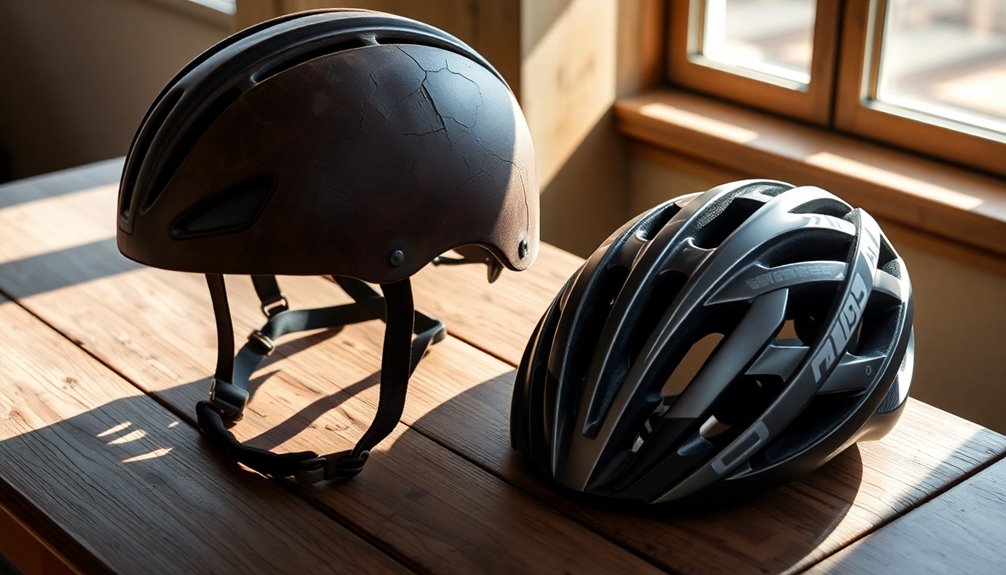
When cycling first gained traction in the 1880s, the need for protection led to the invention of bicycle helmets made from pith, a lightweight plant material.
These early helmets provided minimal protection and easily crushed upon impact, offering little defense against head injuries.
As cycling's popularity surged in the early 1900s, riders sought better helmet safety, prompting the use of wool and leather combinations for slightly improved protection.
However, by the 1970s, it became clear that these helmets weren't sufficient.
This realization paved the way for the introduction of the first effective helmet featuring a hard plastic shell and foam padding in 1975.
This marked a significant milestone, setting the stage for the evolution of safer cycling gear.
Advancements in Safety Standards
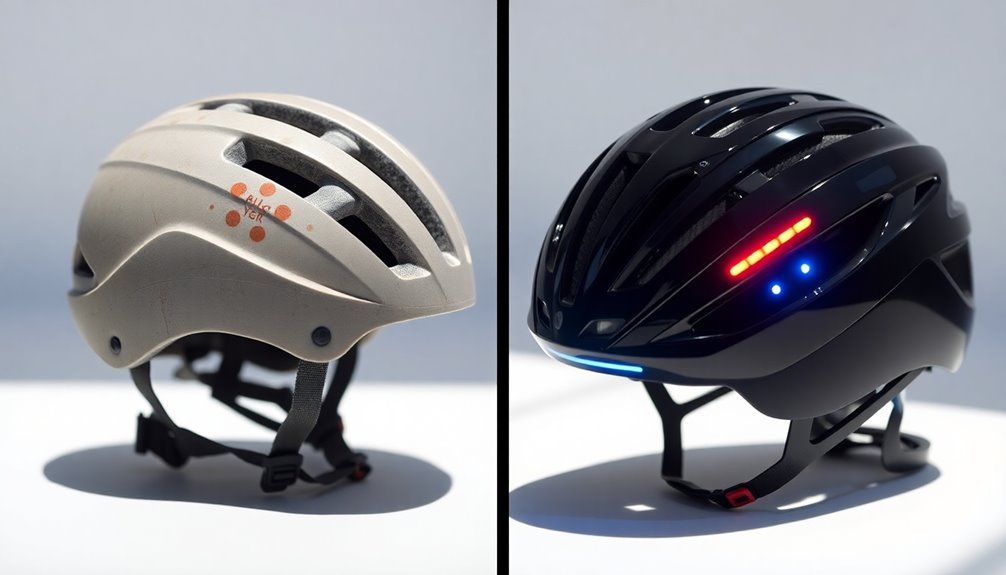
The evolution of cycling helmets didn't just stop with the introduction of more effective designs; it also sparked a demand for improved safety standards. In 1970, the Snell Foundation introduced the first U.S. bicycle helmet standard, revealing the need for specific regulations.
By 1984, the American National Standards Institute (ANSI) established a workable bike helmet standard, leading to essential advancements in helmet quality. Research in the '70s highlighted performance discrepancies among brands, prompting standardized helmet testing.
The Snell Foundation revised its standards in 1985, incorporating EPS foam liners and hard shells to enhance protection. However, current federal testing standards lag behind, neglecting new helmet technology like MIPS and Wavecel, which are designed to further reduce concussion risks.
Innovations in Helmet Design and Materials
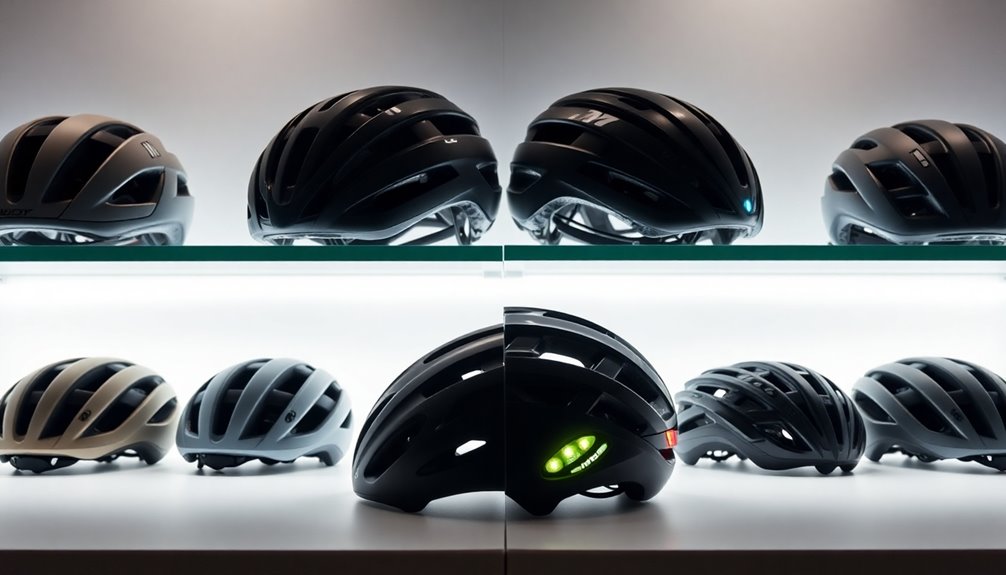
As you explore innovations in helmet design and materials, you'll notice a shift towards advanced materials that enhance safety and comfort.
Custom fit technologies are gaining popularity, allowing helmets to adapt perfectly to your head shape.
Plus, enhanced safety features are now standard, offering better protection than ever before.
Advanced Materials Development
Though advancements in cycling helmet materials might seem subtle, they've dramatically transformed safety and comfort in recent decades.
Early designs, like the Bell Lil Bell Shell, paved the way for lighter helmets that prioritize impact protection. The 1990s introduced advanced materials like polycarbonate and EPP foam, considerably reducing weight while enhancing safety.
Pro Tec's innovation of internal reinforcement in all-EPS helmets strengthened structural integrity upon impact. Furthermore, the introduction of Zorbium foam further improved shock absorption capabilities, making helmets more effective during crashes.
Today, companies like KAV Sports leverage 3D printing technology to refine helmet design, creating custom-fit helmets that cater to individual head shapes, ensuring ideal comfort and protection for every cyclist on the road.
Custom Fit Technologies
While helmet safety has always been a priority, the rise of custom fit technologies has revolutionized how cyclists protect themselves.
Today, you can find helmets on the market that utilize 3D printing to create personalized designs based on your individual measurements. These innovations include adjustable straps and convenient plastic buckles, enhancing usability.
Advanced materials like thermoplastic polyurethane and carbon fiber optimize head protection against both rotational and linear forces during impacts.
Additionally, newer designs feature supplemental stabilizers, ensuring your helmet stays securely in place while riding. Some helmets even cater to specific needs, offering ponytail ports and enhanced venting technologies for better airflow and comfort.
With these custom fit technologies, you're guaranteed a safer, more comfortable cycling experience. Moreover, the incorporation of advanced materials has significantly increased the effectiveness of head protection during cycling accidents.
Enhanced Safety Features
- MIPS (Multi-Directional Impact Protection System) reduces rotational forces during impacts.
- Wavecel technology enhances concussion protection by absorbing impact energy.
- Advanced materials like polycarbonate and EPP foam allow for multi-impact protection.
- Improved ventilation systems keep you comfortable while riding.
These innovations signify a leap forward in helmet design, addressing both safety and comfort. Additionally, energy efficiency in manufacturing processes contributes to the overall sustainability of helmet production.
With lighter materials and tailored fits, modern helmets guarantee you're well-protected against impacts without sacrificing ride quality.
As cycling continues to evolve, so do the technologies designed to keep you safe on the road.
The Role of Fit and Customization
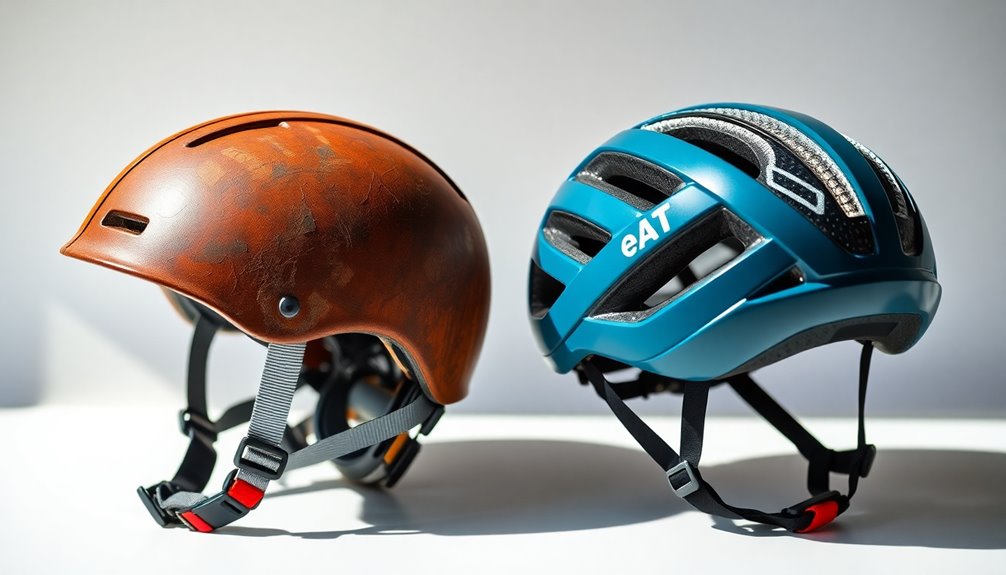
As cycling safety continues to evolve, the importance of helmet fit and customization has never been clearer. Companies like KAV Sports are leading the way with innovative designs, offering 3D printed helmets tailored to your unique head shape and size. This personalized fit enhances comfort and safety, making your ride more enjoyable.
Recent advancements in helmet straps and buckles also improve user convenience, moving away from traditional D-rings to easier plastic buckles for quick adjustments. While self-adjusting fit helmets are still in the works, features like varying venting technologies and ponytail ports for women demonstrate a commitment to effective customization.
Ultimately, prioritizing fit and design in helmets reflects a growing recognition of personalized safety equipment in cycling.
Safety Features and Technology Integration

Modern cycling helmets are packed with innovative safety features that markedly enhance rider protection. With technology integration at the forefront, today's helmets offer you more than just basic coverage.
Modern cycling helmets combine cutting-edge technology and safety features, offering riders enhanced protection beyond standard coverage.
Consider these advancements:
- MIPS technology reduces rotational forces during impacts.
- Bluetooth connectivity allows for hands-free communication and GPS navigation.
- Advanced ventilation systems improve airflow and comfort.
- Custom-fit helmets produced via 3D printing guarantee a snug, personalized fit.
These modern cycling helmets utilize advanced materials like thermoplastic polyurethane and carbon fiber, making them 25% more impact-resistant than national safety standards.
Sustainability Efforts in Helmet Manufacturing

As you consider the sustainability efforts in helmet manufacturing, you'll notice a shift toward eco-friendly materials.
Brands are experimenting with innovative designs, like Giro's use of cornstarch in their Silo model.
However, recycling helmets remains a challenge, particularly with EPS foam, highlighting the need for better disposal options.
Eco-Friendly Materials Utilization
While environmental concerns have surged in recent years, helmet manufacturers are increasingly turning to eco-friendly materials to lessen their impact on the planet.
This shift towards sustainability is reshaping helmet production, offering you safer and greener options.
- Manufacturers like Urge lead the way with recycled materials.
- Giro's Silo model features a liner made from cornstarch.
- The cycling industry is witnessing a growing demand for eco-friendly products.
- Sustainable production methods are becoming a standard expectation.
These advancements reflect a commitment to reducing ecological footprints while meeting consumer needs.
As you shop for your next helmet, consider how these eco-friendly materials contribute to a more sustainable future.
Your choice can make a difference in promoting responsible manufacturing practices.
Recycling Initiatives and Challenges
Although recycling initiatives in the helmet industry have gained momentum, significant challenges remain. Many helmets, especially those made with expanded polystyrene (EPS), face limited recycling options. Since 2015, environmental concerns have pushed manufacturers to explore sustainable materials. Companies like Urge have led the way, offering helmets crafted from recycled materials, while Giro's Silo model features a biodegradable cornstarch liner.
| Challenge | Current Status | Sustainable Solutions |
|---|---|---|
| Limited Recycling | Low recycling rates for helmets | Increased awareness of recycling |
| Material Options | EPS dominance | Development of new materials |
| End-of-Life Solutions | Few options for disposal | Industry collaboration needed |
Despite progress, effective recycling methods for helmets are still lacking, highlighting the need for better end-of-life solutions in manufacturing.
The Impact of Research on Helmet Safety
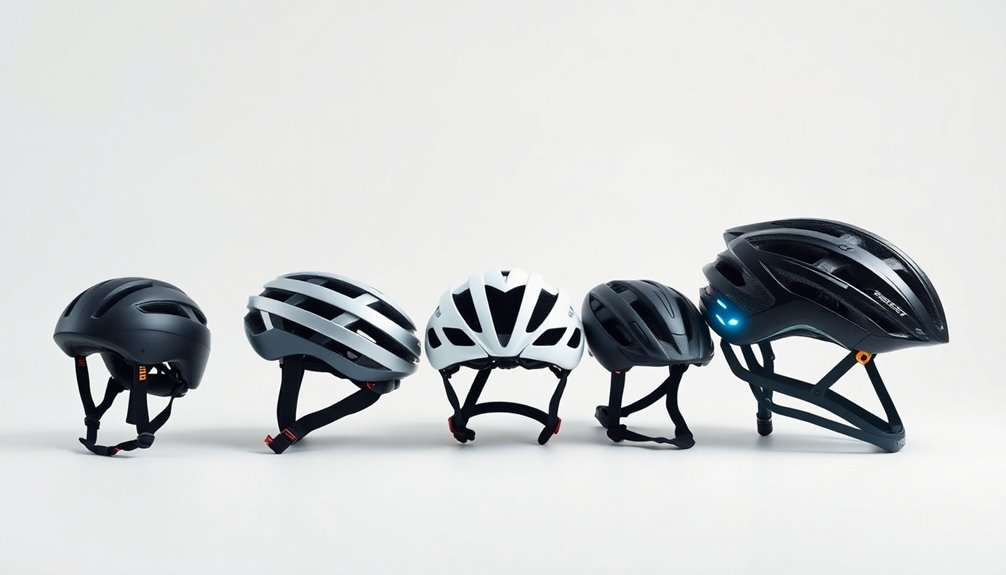
Research has played a pivotal role in enhancing helmet safety, ensuring cyclists have better protection against head injuries. Here's how it's made an impact:
- The Snell Foundation's 1970s findings led to basic safety criteria for bike helmets.
- ANSI established helmet codes in 1984, improving overall helmet quality.
- Independent testing at Virginia Tech rated 69 helmets, showcasing advanced technologies like MIPS.
- Studies show cycling causes around 85,389 head injuries yearly, highlighting the importance of helmet safety research.
These efforts have considerably reduced the risk of traumatic brain injuries by setting standards and encouraging innovations.
Ongoing research continues focusing on real-world crash data, ensuring that future helmets will provide even greater protection for cyclists on the road.
Future Trends in Cycling Helmet Development

As technology evolves, cycling helmets are set to undergo remarkable transformations that enhance rider safety and experience.
Future helmets will likely integrate real-time health monitoring systems, tracking your essential signs and alerting you to potential medical issues. Advanced crash detection technologies will automatically notify emergency services in case of severe impacts, ensuring rapid assistance.
Additionally, augmented reality capabilities may project navigation and safety information directly onto your visor, keeping you informed without distraction. With artificial intelligence, helmets could learn your riding habits, optimizing safety features for your unique style.
Finally, manufacturers are exploring biodegradable materials and recycling programs, focusing on sustainability to reduce environmental impact while keeping you safe on the road.
Frequently Asked Questions
How Have Bike Helmets Changed Over Time?
Bike helmets have changed considerably over time.
They've evolved from basic pith designs to advanced models featuring hard plastic shells and foam padding.
You'll notice that modern helmets are lighter and utilize materials like expanded polystyrene for better impact absorption.
Now, some helmets even have smart technology, offering Bluetooth connectivity and health monitoring.
These advancements guarantee you're not just protected but also connected while riding, enhancing your overall cycling experience.
What Are the Evolutions of Helmets?
Helmets have evolved considerably over time.
You'll notice the shift from basic pith models to leather versions that provided a bit more safety.
The 1970s introduced hard plastic shells with foam padding, improving protection.
By the 1980s, standards emerged, leading to better designs with expanded-polystyrene liners.
In the 1990s, lighter materials enhanced comfort and aerodynamics.
Today, smart helmets offer features like Bluetooth and advanced safety technologies, making your ride even safer and more connected.
Is a 10 Year Old Bicycle Helmet Still Good?
Picture yourself riding a vintage bike, feeling the wind in your hair.
But when it comes to your helmet, a 10-year-old one just isn't gonna cut it.
Over time, helmets degrade and lose their ability to absorb impacts effectively.
Plus, they mightn't meet current safety standards.
You should replace it every 3 to 5 years to guarantee you're protected.
Staying safe on your ride means using up-to-date gear that meets today's standards.
What Is the 2 2 2 Rule When Fitting a Helmet on Your Head?
The 2 2 2 rule for fitting a helmet is simple and essential for safety.
First, make certain there's a two-finger gap between your eyebrows and the helmet's front edge.
Next, check the side straps; they should form a "V" shape just below your ears.
Finally, the back of the helmet should sit level on your head.
When buckled, you should fit two fingers under the chin strap, and the helmet shouldn't move when you shake your head.
Conclusion
As you ride into the future, it's clear that cycling helmets have transformed from simple protective gear to cutting-edge safety devices. With innovations that blend comfort, technology, and sustainability, you're not just wearing a helmet; you're donning a fortress for your head! Embrace the evolution of these lifesavers, as they keep you safe while you conquer the open road. Remember, every ride is a chance to enjoy the thrill of cycling with confidence and peace of mind.









